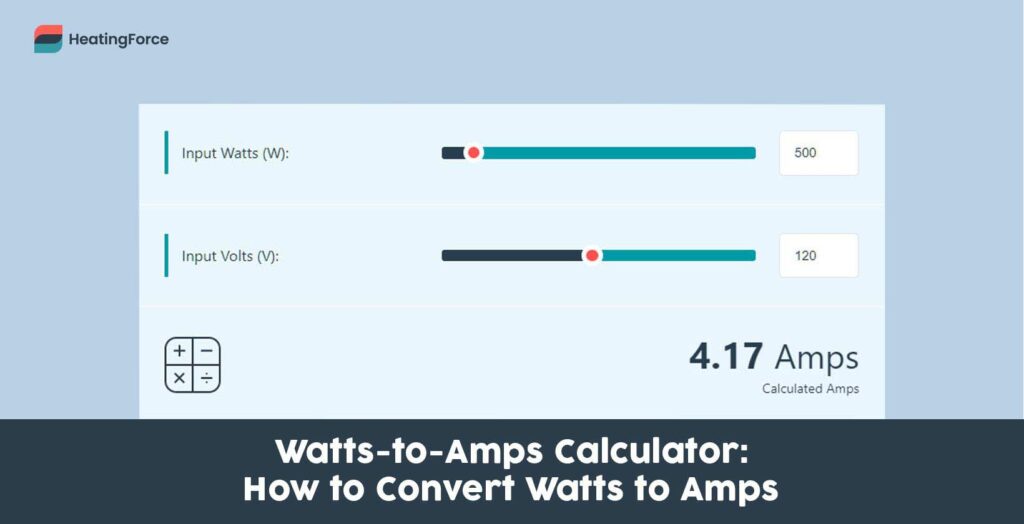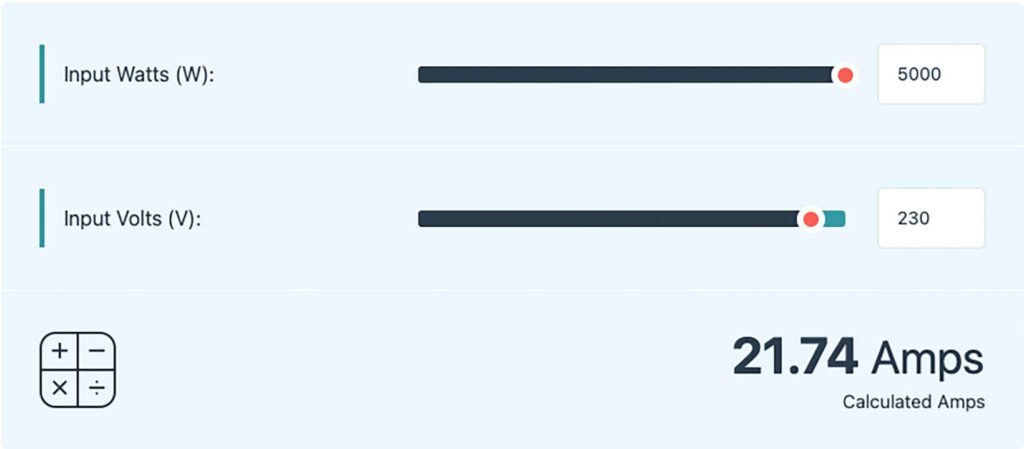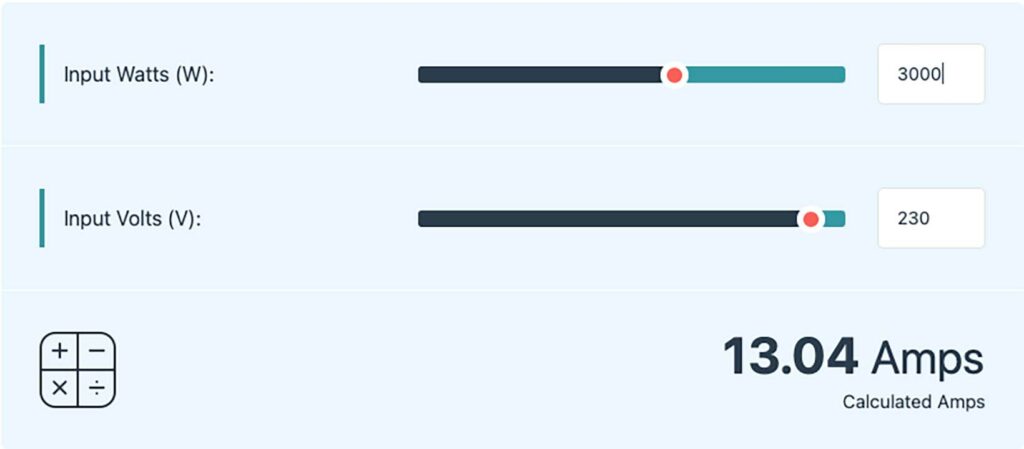Watts to Amps Calculator, Conversion Formula, 230V, 120V, and 24V Conversion Tables

Watts-to-amps conversions help derive the electrical current (also knows as amperage) that an electronic device of a given wattage will draw at a specific voltage. Calculating the amperage based on wattage has many practical applications at home and in various workplaces. However, the primary purpose of watts-to-amps conversions is to ensure that a specific appliance connects to a circuit that can withstand the electrical current.
It’s impossible to convert watts to amps directly because these units of measure quantify different properties. What watts-to-amps calculations really measure is how the relationship between wattage and voltage affects the current. To perform watts-to-amps conversions correctly, it’s vital that you understand what watts, amps, and volts mean, and how these units of measure are interrelated.
In this article, you will learn what watts, amps, and Volts are, and how their relationship can help you arrive at the watts-to-amps conversion formula. We will also walk you through practical examples of watts-to-amps conversions and give you access to a simple watts to amps calculator and handy conversion tables.
How to use the watts to amps calculator
To use the watts to amps calculator, you should follow the three steps below.
- Enter the power in watts (W)
- Enter the voltage in Volts (V)
- Check the display to see the current in amps (A)
The watts-to-amps calculator below is a straightforward online calculator that lets you convert watts to amps right here on the screen. However, you can convert watts to amps without a calculator. Below, you will gain in-depth knowledge of how to convert electrical power in watts to electrical current in amperes manually.
How do you convert watts to amps manually?
To convert watts to amps manually (without the calculator above), you’ll have to use the following formula:
I (Current in amps) = P (Power in watts) / V (Electric Potential in Volts)
However, note that watts and amps measure different properties, and thus cannot be converted directly. Instead, the watts-to-amps conversion shows the correlation between the electrical power and the electrical current, and this interrelationship has a real impact on how you use your household electronics.
What’s the relationship between watts, amps, and Volts?
The relationship between watts, amps, and Volts is as follows — 1 Volt being moved by 1 amp of current produces 1 watt of electrical power. Since watts, amps, and Volts are interrelated, you can convert watts to amps if you already know the wattage and the voltage. For example, if you’re aware of the voltage in your socket (V), and the power of the appliance (W) you’re about to plug in, you can calculate the current flow (I) that the appliance will draw.
To better understand the relationship between watts and amps, you’ll first have to learn what watts, amps, and Volts measure in electrical formulae.
What are watts?
Watts (W/kW) are units of measure that quantify the electrical power (aka wattage, used interchangeably), or the rate of energy transfer of 1 Volt by 1 ampere of current flow through a conductor. When you see a power indicator on an appliance, it tells you how many units of power the appliance requires to operate without overloading your fuse.
What are amps?
Amps (A), or amperes, are units of measure that show the strength of the electrical current (amperage) — the rate at which the electric current flows through a conductor, like a wire. The size of the wire and fuse dictate the maximum electrical current that the fuse can sustain before getting blown.
What is a Volt?
A Volt (V) is a unit of measure that depicts the electrical potential (voltage) when a single ampere of current carries one watt of power between two points of a conductor, such as a wire. Knowing the voltage is essential to performing the watts to amps calculation. In the common water hose analogy, voltage is comparable to the water pressure, whilst the amps represent the flow. Most sources of electric energy, such as power sockets and batteries, specify their voltage — that’s the electric potential difference you can expect when you connect the source of power to an appliance.
How do you convert watts to amps with a given voltage?
To convert watts to amps with a given voltage, you divide the wattage by the voltage. Below are two examples that show watts-to-amps calculations with a known voltage.
Example 1 — How many amps is 5,000 watts?
To find out how many amps is 5,000 watts, let’s assume a standard residential electrical supply voltage of 230V and divide watts by Volts:
Required amperage = 5000W / 230V
Required amperage = 21.74A
You can plug these values into the watts to amps calculator to get the same answer:

Example 2 — How many amps is 3,000 watts?
To learn how many amps is 3,000 watts, we’ll assume a standard, 230V residential UK power socket and divide the watts by the Volts:
Required amperage = 3000W / 230V
Required amperage = 13.04A
Our watts-to-amps calculator confirms the result:

How do you calculate watts in an amp at a given voltage?
To calculate watts in an amp at a given voltage, you can use the following formula — P (Power in watts) = I (Current in amps) x V (Electric Potential in Volts). An amps to watts calculation may be necessary if you already know the amperage, but aren’t sure if it can handle a given appliance. Below are 2 examples of amps to watts calculations when you know the voltage.
Example 1 — How many watts are in one amp?
To find out how many watts are in one amp, you can multiply 1 amp by the voltage (we can assume the standard, 230V residential outlet).
Maximum power = 1A x 230V
Maximum power = 230W
In the example above, you can see that a 1-amp conductor can only handle 230 watts of power. This is hardly a realistic scenario, because the standard household fuse in the UK is 13 amps. So, let’s find out how much power a typical residential fuse can sustain without getting blown in the next example.
Example 2 — How many watts can a 13-amp fuse take?
To find out how many watts a 13-amp fuse can take, you can multiply 13 amps by the standard residential voltage (230V).
Maximum power = 13A x 230V
Maximum power = 2,990W
How do you convert watts to amps with a three-phase current?
To convert watts to amps with a three phase current, you’ll need to use the two formulae below, both of which include a new value — the “power factor.” The power factor is equal to Real Power divided by Apparent Power (W/VA). Which of the two formulae you use depends on whether you’ve got line-to-line or line-to-neutral voltage.
Converting watts to amps with line-to-line voltage:
I (Current in amps) = P (Power in watts) / (√3 x Power Factor x Line-to-line voltage)
Converting watts to amps with line-to-neutral voltage:
I (Current in amps) = P (Power in watts) / (√3 x Power Factor x Line-to-neutral voltage)
Watts to amps conversion — practical examples
Watts to amps conversions are useful in household settings where you’re trying to establish whether a particular electronic device will draw less amperage than the circuit and the fuse are designed to sustain. Below, you can see a few practical examples of watts to amps conversions using household electrical appliances.
1. Can I plug a 2,500-watt electric heater into any socket?
To find out if you can plug a 2,500-watt electric space heater into any socket, you’ll have to find out how much current the heater will draw and confirm that this required current is not above the design limits of the circuit and fuse. Assuming a 230V residential socket, you can find out the current needed by the electric heater by dividing the wattage by the voltage:
Required amperage = 2,500W / 230V
Required amperage = 10.87A
As we can see from the watts to amps conversion above, a 2,500W heater would require a current of 10.87 amps, given a fixed voltage of 230V. Since a typical residential socket is protected by a 13A fuse, it’s safe to plug a 2,500W heater into a standard socket — it will not overload the fuse. That said, it’s always best to connect your heater to a dedicated circuit — one that doesn’t supply any other devices. This way, the heater won’t need to share the current with other appliances.
2. How many amps do I need to operate an 11.2kW electric cooker?
To find out how many amps you need to operate an 11.2kW electric cooker, you’ll need to use the watts-to-amps conversion formula and divide the wattage by the voltage. Assuming a standard UK outlet, the watts-to-amps calculation is as follows.
Required amperage = 11,200W / 230V
Required amperage = 48.7A
In this scenario, the watts to amps conversion produces an amperage of 48.7 amps — a standard socket won’t do. To operate the electric cooker safely, you’ll need a dedicated circuit with a 50 A fuse. You may be tempted to connect the microwave or fridge to the same power outlet, but doing so may overload the wires and cause your breaker to trip frequently.
Watts-to-amps conversion charts
Apart from using the watts-to-amps calculator and performing manual conversions, you can go ahead and use the watts-to-amps conversion charts below. For your convenience, they’re organised by common voltage values.
Watts to amps conversion chart at 230V: UK and EU residential socket
The conversion chart below will help you convert watts to amps quickly if you’ve got an electric supply of 230V, like all homes in the UK.
| Watts to Amps Chart – 230V | ||
| Wattage | Amps at 230V | |
|
3A
Household Fuse |
100 watts at 230 Volts | 0.43 amps |
| 200 watts at 230 Volts | 0.87 amps | |
| 300 watts at 230 Volts | 1.30 amps | |
| 400 watts at 230 Volts | 1.74 amps | |
| 500 watts at 230 Volts | 2.17 amps | |
| 600 watts at 230 Volts | 2.60 amps | |
| 700 watts at 230 Volts | 3.04 amps | |
|
13A
Household Fuse |
800 watts at 230 Volts | 3.48 amps |
| 900 watts at 230 Volts | 3.91 amps | |
| 1000 watts at 230 Volts | 4.35 amps | |
| 1100 watts at 230 Volts | 4.78 amps | |
| 1200 watts at 230 Volts | 5.22 amps | |
| 1300 watts at 230 Volts | 5.65 amps | |
| 1400 watts at 230 Volts | 6.09 amps | |
| 1500 watts at 230 Volts | 6.52 amps | |
| 1600 watts at 230 Volts | 6.96 amps | |
| 1700 watts at 230 Volts | 7.39 amps | |
| 1800 watts at 230 Volts | 7.83 amps | |
| 1900 watts at 230 Volts | 8.26 amps | |
| 2000 watts at 230 Volts | 8.70 amps | |
| 2500 watts at 230 Volts | 10.87 amps | |
| 3000 watts at 230 Volts | 13.04 amps | |
|
20A-60A Breaker Required
|
5000 watts at 230 Volts | 21.73 amps |
| 10000 watts at 230 Volts | 43.48 amps | |
| 12000 watts at 230 Volts | 52.17 amps | |
| 13000 watts at 230 Volts | 56.52 amps | |
Watts to amps conversion chart at 120V: US, Canada, Mexico, and Central American Residential Socket
You can use the conversion charts below for quick watts to amps calculations if you’re using residential outlets in the US, Canada, Mexico, and most Central American countries, which supply 120V. Mexico has a standard voltage of 127V, which is generally safe for US and Canadian devices.
| Watts to Amps Chart – 120V | ||
| Wattage | Amps at 120V | |
| 100 watts at 120 Volts | 0.83 amps | |
| 200 watts at 120 Volts | 1.67 amps | |
| 300 watts at 120 Volts | 2.50 amps | |
| 400 watts at 120 Volts | 3.33 amps | |
| 500 watts at 120 Volts | 4.17 amps | |
| 600 watts at 120 Volts | 5.00 amps | |
| 700 watts at 120 Volts | 5.83 amps | |
| 800 watts at 120 Volts | 6.67 amps | |
| 900 watts at 120 Volts | 7.50 amps | |
| 1,000 watts at 120 Volts | 8.33 amps | |
| 1,100 watts at 120 Volts | 9.16 amps | |
| 1,200 watts at 120 Volts | 10.00 amps | |
| 1,300 watts at 120 Volts | 10.83 amps | |
| 1,400 watts at 120 Volts | 11.67 amps | |
| 1,500 watts at 120 Volts | 12.50 amps | |
| 1,600 watts at 120 Volts | 13.33 amps | |
| 1,700 watts at 120 Volts | 14.17 amps | |
| 1,800 watts at 120 Volts | 15.00 amps | |
| 1,900 watts at 120 Volts | 15.83 amps | |
| 2,000 watts at 120 Volts | 16.67 amps | |
| 3,000 watts at 120 Volts | 25.00 amps | |
| 5,000 watts at 120 Volts* | 41.66 amps | |
| 10,000 watts at 120 Volts* | 83.33 amps | |
| 12,000 watts at 120 Volts* | 100.00 amps | |
| 13,000 watts at 120 Volts* | 108.33 amps | |
| *These appliances will generally operate on 240V | ||
Watts to amps conversion chart — 24V Battery
If you’re using a battery with 24V, the conversion chart below will spare you from having to do the watts to amps calculation.
| Watts to Amps Chart – 24V Battery | ||
| Wattage | Amps at 24V | |
| 1 watts at 24 Volts | amps | |
| 10 watts at 24 Volts | 1.67 amps | |
| 50 watts at 24 Volts | 2.50 amps | |
| 100 watts at 24 Volts | 3.33 amps | |
| 200 watts at 24 Volts | 4.17 amps | |
| 300 watts at 24 Volts | 5.00 amps | |
| 400 watts at 24 Volts | 5.83 amps | |
| 500 watts at 24 Volts | 6.67 amps | |
| 600 watts at 24 Volts | 7.50 amps | |
| 700 watts at 24 Volts | 8.33 amps | |
| 800 watts at 24 Volts | 9.16 amps | |
| 900 watts at 24 Volts | 10.00 amps | |
| 1,000 watts at 24 Volts | 10.83 amps | |
| 1,500 watts at 24 Volts | 11.67 amps | |
| 2,000 watts at 24 Volts | 12.50 amps | |
Watts to amps conversion — parting words
We hope our explanation of how watts to amps conversion, as well as the watts to amps calculator and charts, should help you in most practical applications. So, go ahead and bookmark this page for future reference.
And if you have any more questions about watts to amps calculations, please leave us a comment below and we’ll get back to you as soon as possible.
Please note — if you have any doubts that your circuit can handle a specific appliance, don’t rely on the watts to amps conversion alone; always consult with a licensed electrician.
